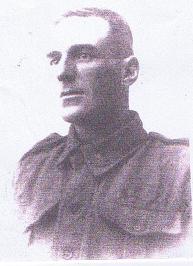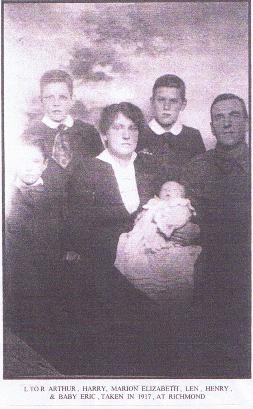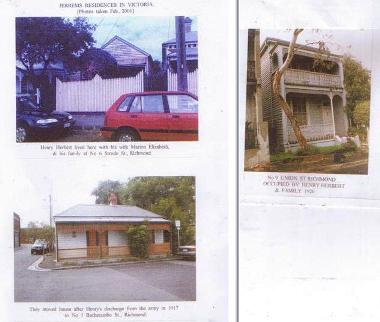Dear Donald,
story below about Anita Veale and Helen Mitchell.
Enjoy.
| Henry Herbert Jerrems |
Ray Jerrems, Our Genealogist, Historian

Introduction
This article is a collection of information about Henry
Herbert Jerrems, the grandfather of our readers Anita
Veale (nee Jerrems) and Ken Jerrems and the great
grandfather of Ben, Tate and Emma. This is my first
article
about the ‘Melbourne’ side of the Jerrems family, the
impetus for writing the article having come from Anita,
who recently supplied me with documents and
photos.
For the sake of convenience I have also included
some
information about Henry’s parents, Robert Cane and
Alice.
Sources of information
My main source of information is the research carried
out
by Noel and Laurel Burns in 2000. I have
supplemented
this information with my own research and the
information and photos passed on to me by Anita.
Robert Cane Jerrems (Henry’s father)
Robert, Henry Herbert’s father, was the ‘founding
father’
of the Melbourne branch of the Jerrems family, being a
member of the Jerrems family which migrated to
Victoria
in the 1850s and settled in Richmond. He was born in
Gainsborough, Lincolnshire in 1849, his parents
being
Thomas Clarke and Elizabeth Jerrems (nee Jepson).
My
great grandfather Charles) was his brother, as was
Donald’s great grandfather (William George). Thomas
died
in 1866 but Elizabeth outlived some of her children,
dying
in 1902.
In 1870 Robert married Alice Rigg, who was born in
1850
in County Cumberland, England (on the Scottish
border)
and her Scottish parents were Thomas and Agnes
Rigg
(nee Carter). He died in 1888.
Robert and Alice had 6 children, Edwin (1871-1929),
Edith
Alice (1873-???), William George (1875-1937),
Gertrude
Amelia (1877-1951), Henry Herbert (1881- 1928) and
Alfred Robert Cain (1883-1940).
After Robert died in 1888 in Richmond his widow Alice
remarried in 1896, to James Alexander Newlands
(b1829
in Scotland, father William Newlands). James died in
Richmond in 1905, aged 76, leaving Alice a widow
once
again. She died in 15th April 1919.
Henry ‘s marriage and children
Born in Richmond in 1881, in 1903 Henry married
Marion
Elizabeth Beddome (she was born in Richmond in
1884,
her parents being William John (born in New York)
and
Elizabeth Beddome (nee Sayce).
Henry and Marion had 4 sons (all of whom were born
in
Richmond except Arthur Ernest, born in Caulfield):
Henry ‘Harry’ Beddome (1904-1955), Leonard William
(1906-1982), Arthur Ernest (1910-1986) and Eric
Alfred
Sayce (1917-1970). Incidentally, Harry married Gladys
Burns, the sister of Noel Burns who carried out the
research on the Jerrems family.
Henry’s Occupations and Addresses
1903 Electoral Roll, 78 Bridge Road Richmond West,
Painter
1909 Electoral Roll, 6 Strode Street, Richmond,
Painter
(see photo of house)
1914 Electoral Roll, 33 Little Lennox Street,
Richmond,
Newsagent
July 1915 Army Enlistment Application, 14 Derby??
Street,
Richmond, Clerk
January 1917 Army Enlistment Application 1
Botherambo
Street Richmond, Newsagent (see photo of house)
1919 Electoral Roll, 1 Botherambo Street, Richmond,
Soldier.
Mid 1920s Employed as typesetter by
Melbourne ‘Argus’.
1928 Death Notice, 9 Union Street, Richmond (see
photo
of house)
Note: Two of Henry’s brothers (including Edwin) were
also shown as painters living in Richmond in the
Electoral
Rolls (Alfred, painter in 1909, 1914, 1919, labourer
1931,
1936), Edwin (painter in 1909, 1914, and 1919), so it
is
possible that the 3 brothers worked together.
The Houses
The house at Strode St was a modest little single
storey
weatherboard house. The larger single storey
weatherboard house at Botherambo St would have
been
a welcome change now that there were 4 boys in the
family. The final house at Union St was a pretty 2
storey
weatherboard house (complete with ‘lace’ verandah
fencing) typical of the ‘terrace houses’ which were so
popular in the inner suburbs of Melbourne and Sydney
in
the late 1800s.
Henry’s War Service in France
The following is a summary of Henry’s war record; I
have
compiled a full account for readers who wish to see it.
Henry first enlisted in July 1915 and was drafted as a
reinforcement for the 29th Battalion. He was
discharged
due to ill health in March 1916. His medical report at
the
time of enlistment shows that he was of medium build
(5ft
6 inches, 9 stone 5 lbs, chest 32-34 inches and half
inches), complexion sallow, eyes grey, brown hair,
Presbyterian.
Henry enlisted again in January 1917 and was drafted
as
a reinforcement for the 38th Battalion.
At all stages he was listed as a private.
He embarked from Melbourne for England in June
1917
and trained in England until late December, when he
was
sent to France to reinforce the 38th Battalion. .
Belgium had been the focus of the 38th Battalion’s
activities when Henry joined it, until it was rushed
south
to France in late March 1918 to meet the German
Army’s
massive Spring Offensive. The Allies were flung back
over the areas they had conquered at great loss over
the
previous years, however the Allies countered this by
launching their own offensive on 8 August 1918.
Henry’s
Battalion was also involved in an ill-conceived attack
that
failed to capture the village of Proyart on 10 August.
Undaunted, the battalion continued to play an active
role
throughout August and early September in the 3rd
Division’s advance along the notorious Somme Valley,
where the fighting was fierce.
Shortly after this (on 23.9.18) he went to hospital with
myalgia (muscle soreness), spending a total of a little
over
5 months in hospital. By the time he was discharged
from
hospital the war had of course ended and a few
months
later he returned to Australia, disembarking in
Melbourne
on 8.6.19. His family’s happiness at his return would
have
been tinged with some sadness because his mother
Alice
had passed away about 7 weeks earlier.
In due course Henry was awarded the British War
Medal
and the Victory Medal.
The fact that Henry spent 5 months in hospital in
France
indicates that his war service had taken a heavy toll on
him, and this may have carried over to his civilian life
later,
as it did with my grandfather. A note from Joyce
Jerrems
passed on to me by Anita Veale refers to Henry as
having retired from working at the ‘Argus’ newspaper
due
to gas damaged lungs (‘gas’ being poison gas
released by
the Germans).
Over 300,000 Australians volunteered to serve on the
Western Front in the First World War, and over 50,000
were killed and a similar number were wounded or
injured. There were also a large number who
were ‘gassed’, many of whom were treated in the field
and not recorded in the Army’s medical records. In
many
cases the after-effects of the gassing lasted for years,
culminating in death from lung problems.
Henry was one of many heroes who volunteered to
serve their country, and finally paid the price. We will
remember him.
Richmond
The Melbourne suburb of Richmond and its fluctuating
fortunes played an important role for the Jerrems
family,
so I have spent some time researching its history.
Thomas Jerrems’ family migrated to Melbourne in the
1850s and settled in Richmond. Most of the family
moved
away over a period of time, but Robert Cane Jerrems,
his
brother Arthur Reginald and mother Elizabeth stayed
there, as did Robert’s children, including Henry.
Richmond
therefore formed an integral part of the life of Henry,
his
parents and his descendants for a period of over 70
years.
Richmond is situated on flat to lightly undulating land
on
the east bank of the Yarra River downstream of
Melbourne. It was only 2 miles (3.5 km) from the
centre of
Melbourne. The area was mainly settled from the mid
1840s onwards. The population was 7000 in 1854, an
estimated 11,000 in 1865, blowing out to 23,000 in
1881
(the year after Henry Herbert Jerrems was born). In
1961
the population was 34,000 and in 2006 it had returned
to
the 1881 level (22,475). The reduction was partly
attributable to a slum clearance programme initiated
after
the Second World War.
Although the rate of settlement in the 1850s was brisk
it
tended to concentrate in particular areas. For instance
there was a large Catholic population, probably
boosted
by former Irish miners and their families, concentrated
below the Richmond Hill area. Richmond Hill itself
(where
Anita attended school many years later in the 1940s)
was
settled by well-to- do professional people. But in the
1860s a further pattern emerged of cheap sub
standard
housing being built by opportunistic landlords in
enclaves,
particularly on former dairy land in flood prone areas
adjacent to the Yarra River. This was followed in the
1870s by the construction of large areas of low-cost
workmen’s cottages.
When Thomas brought his family from England to
Richmond in 1860 there was another more sinister
trend
which was to cast a pall, both literally and figuratively,
over the area for many years to come. There were
already brickpits, tanneries and abattoirs there, but
this
industrialisation was soon to expand significantly.
Uncontrolled by any Government or Council
requirements
the factories emitted a stench, dumped their waste in
the
River and exploited the workers.
On a more positive note, by the early 1860s a Town
Hall
had been built, and there two blocks of shops on the
main
road. In the 1850s there were church schools, and
then a
State school (possibly attended by the Jerrems
children)
opened in Lennox Street in 1858.
Thomas had died in 1866, leaving his wife Elizabeth
(in
her forties) to bring up a large family on her own in
Richmond, and this theme carried through to the next
generation when Henry’s father Robert died there in
1888, leaving Alice at the age of 38 to bring up 6
children
aged between 5 and 17. This would have placed Alice
in
a very difficult financial position and her prospects of
moving out of the area if she had wished to do so
would
have been scuttled. Quite likely she had a network of
supportive relatives (for instance her mother-in-law
Elizabeth, her sister-in-law Catherine and her brother-
in-
law Arthur) and friends in Richmond and she would
not
have contemplated leaving it anyway.
One particular effect on Alice’s children (including
Henry)
of Robert’s early demise could have been that her
children had to leave school early. It is in fact possible
that one brother (William George) was illiterate
because
his name was spelled “Jerram” on his Army
Enlistment
Application. His occupations were also consistent
with
this (labouring and cleaning).
By the turn of the century Richmond had gone downhill
significantly, and was becoming known for its high
incidence of low standard of living and high industrial
content. It had a number of factories including glass,
nail,
lime and cement, soap and candle, hosiery, tanning,
and
white lead, plus a quarry and two electric light works.
However, no doubt Richmond was “home” and a
known
quantity to Henry and his brother Edwin regardless of
its
growing socio-economic detractions. Being from a
well
established family in the area would have stood Henry
in
good stead later as a newsagent, just as it would
have
done earlier when he and Edwin were painters.
There is a useful book about Richmond (McCalman,
Janet, “Struggletown: Public and Private Life in
Richmond
1900-1965”, Melbourne University Press, 1984).
Some of
the above information comes from the book. The book
does not refer to the Jerrems family at all.
Henry and Marion’s family
Turning to Henry and Marion;s family of 4 boys (Henry
Harry Beddome (1904-1955), Leonard William (1906-
1982), Arthur Ernest (1910-1986) and Eric Alfred
Sayce
(1917-1970), three were obviously born before the
War,
and one latecomer (Eric) was born during the War in
1917.
Bringing up the boys, particularly during Henry’s
absences in the Army, would have kept Marion busy.
From a financial viewpoint the Army pay was good, but
his absence from his newsagency would have left
Marion with the additional responsibility of arranging
for
someone to look after the newsagency during his
absence.
Death of Henry and Marion
Henry died on 13th July 1928 at Richmond aged 47
and
Marion died at the same age on 14th April 1931, in
Richmond. Three of their children were grown up
when
their parents died but Eric was only 11 when his father
died and 14 when his mother died.
Looking at the family photo taken in 1917, before
Henry
set off for England on war service, it is sad to think that
within 14 years Henry and Marion had passed away at
comparatively young ages.
Sadly, Marion’s death certificate shows that she had
colon cancer when she died in a private hospital.
Conclusion
I am pleased that I have finally written an article about
the
Melbourne Jerrems families. I have started drafting
further
articles about Henry and Marion’s children, and
Henry’s
brother Edwin.
| The Stork has been Busy |
Ray Jerrems
The Jerrems Tree Grows
In the January edition of the Journal we referred to
Helen Mitchell, who is a great great grand-
daughter of Robert Cane Jerrems (her great
grandfather Edwin being a son of
Robert). Helen recently sent us the following
email:
Hello Ray, just letting everyone know I am a nana
again. My second daughter Jenni has just had
a little girl Matilda Kimberley Hare. Both are
well. She weighed in at 7lb 10oz. Regards Helen.
We also heard recently from Anita Veale (nee
Jerrems), who supplied information and photographs
for the previous article about her grandfather
Henry Herbert Jerrems (coincidentally she is
a great grand-daughter of Robert Cane
Jerrems). Not to be outdone, Anita and George
are now great grandparents for the first time, thanks to
the arrival of Chloe Elise Berka. Anita and
George now join the elite band of readers who are
great grandparents.
We extend our congratulations to all concerned, and
trust that the little girls are well.
| AMAZING UPDATE ON ANITA AND HELEN |
Ray Jerrems
After Ray had received letters from Anita Veale and
Helen Mitchell and compared their addresses he
realised that they virtually live in the same suburb of
Melbourne.
This was amazing enough, when one realizes that
their
ancestors probably lost touch with each other about
80
years ago. But added to this is a further coincidence.
When he told Helen where Anita lived she said that
her
youngest daughter Kelli went to school with a Kate
Veale. Anita Veale confirmed that Kate is her grand
daughter.
Melbourne has a population of over 3 million people,
making these coincidences even more remarkable.
|
Jerrems Residences in Victoria (photos Henry Herbert lived here with his wife Marion Elizabeth and his family at #6 The moved house after Henry’s discharge from the Army in 1917 to #1 #9 Union Street Richmond Occupied by Henry Herbert and family 1926. (two |


